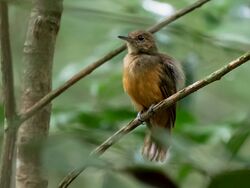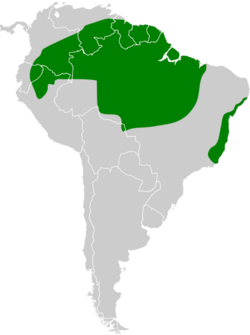Biology:Cinereous antshrike
From HandWiki
Short description: Species of bird
| Cinereous antshrike | |
|---|---|

| |

| |
| Scientific classification | |
| Domain: | Eukaryota |
| Kingdom: | Animalia |
| Phylum: | Chordata |
| Class: | Aves |
| Order: | Passeriformes |
| Family: | Thamnophilidae |
| Genus: | Thamnomanes |
| Species: | T. caesius
|
| Binomial name | |
| Thamnomanes caesius (Temminck, 1820)
| |

| |
The cinereous antshrike (Thamnomanes caesius) is an insectivorous bird in the antbird family Thamnophilidae. The term cinereous describes its colouration. It is found in Bolivia, Brazil , Colombia, Ecuador, French Guiana, Guyana, Peru, Suriname, and Venezuela. Its natural habitat is subtropical or tropical moist lowland forests.
The cinereous antshrike was described by the Dutch zoologist Coenraad Jacob Temminck in 1820 and given the binomial name Muscicapa caesius.[2][3] It is now placed in the genus Thamnomanes which was introduced by the German ornithologist Jean Cabanis in 1847.[4] The specific epithet caesius is the Latin for "bluish gray".[5]
There are five subspecies:[6]
- T. c. glaucus Cabanis, 1847 – east Colombia to northeast Peru, the Guianas and north Brazil
- T. c. persimilis Hellmayr, 1907 – central Brazil
- T. c. simillimus Gyldenstolpe, 1951 – south central Brazil
- T. c. hoffmannsi Hellmayr, 1906 – east central Brazil
- T. c. caesius (Temminck, 1820) – east Brazil
References
- ↑ BirdLife International (2016). "Thamnomanes caesius". IUCN Red List of Threatened Species 2016: e.T22701420A93828950. doi:10.2305/IUCN.UK.2016-3.RLTS.T22701420A93828950.en. https://www.iucnredlist.org/species/22701420/93828950. Retrieved 12 November 2021.
- ↑ Temminck, Coenraad Jacob (1838) (in French). Nouveau recueil de planches coloriées d'oiseaux, pour servir de suite et de complément aux planches enluminées de Buffon. 3. Paris: F.G. Levrault. Plate 17, Figs. 1 & 2. https://biodiversitylibrary.org/page/36704823. The 5 volumes were originally issued in 102 parts, 1820-1839
- ↑ Peters, James Lee, ed (1951). Check-list of Birds of the World. 7. Cambridge, Massachusetts: Museum of Comparative Zoology. p. 188. https://biodiversitylibrary.org/page/14480525.
- ↑ Cabanis, Jean (1847). "Ornithologische notizen" (in German). Archiv für Naturgeschichte 13: 186–256 [230]. https://biodiversitylibrary.org/page/14785200.
- ↑ Jobling, J.A. (2018). "Key to Scientific Names in Ornithology". in del Hoyo, J.; Elliott, A.; Sargatal, J. et al.. Handbook of the Birds of the World Alive. Lynx Edicions. https://www.hbw.com/dictionary/key-to-scientific-names-in-ornithology?name=caesius.
- ↑ Gill, Frank; Donsker, David, eds (2018). "Antbirds". World Bird List Version 8.1. International Ornithologists' Union. http://www.worldbirdnames.org/bow/antbirds/.
External links
Wikidata ☰ Q1273014 entry
 |


